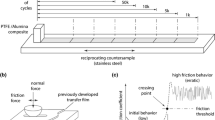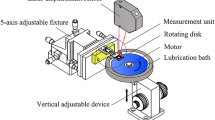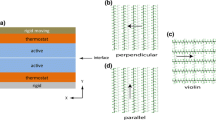Abstract
Under macroscopic pin-on-disk testing the sliding friction coefficient of Polytetrafluoroethylene (PTFE) was investigated over a temperature range of approximately 200–400 K. This study examines the nature of the temperature dependence by testing PTFE pins at varying temperature and humidity on a linear reciprocating pin-on-disk tribometer. The friction coefficient increased monotonically with decreasing temperature from μ = 0.075to μ = 0.210 in a manner consistent with thermal activation; it deviated from this trend only during phase and glass transitions in the PTFE and temperatures below the frost-points for the respective environments.



Similar content being viewed by others
References
Gardos, M.N.: Self-lubricating composites for extreme environment applications. Tribol. Int. 15, 273−283 (1982)
Miyoshi, K.: Aerospace mechanisms and tribology technology-case study. Tribol. Int. 32, 673–685 (1999)
Zhao, X., Shen, Z., Xing, Y., Ma, S.: An experimental study of low earth orbit atomic oxygen and ultraviolet radiation effects on a spacecraft material-polytetrafluoroethylene. Polym. Degr. Stabil. 88, 275–285 (2005)
McCook, N.L., Burris, D.L., Dickrell, P.L., Sawyer, W.G.: Cryogenic friction behavior of PTFE based solid lubricant composites. Tribol. Lett. 20, 109–113 (2005)
Gradt, T., Schneider, T., Hubner, W., Borner, H.: Friction and wear at low temperatures. Int. J. Hydrogen Energ. 23, 397–403 (1998)
Hubner, W., Gradt, T., Schneider, T., Borner, H.: Tribological behaviour of materials at cryogenic temperatures. Wear 216, 150–159 (1998)
Theiler, G., Hubner, W., Gradt, T., Klein, P., Friedrich, K.: Friction and wear of PTFE composites at cryogenic temperatures. Tribol. Int. 35, 449–458 (2002)
McLaren, K., Tabor, D.: Visco-elastic properties and friction of solids - friction of polymers - influence of speed and temperature. Nature 197, 856 (1963)
Makinson, K., Tabor, D.: Friction and transfer of polytetrafluoroethylene. Nature 201, 464 (1964)
Pooley, C.M., Tabor, D.: Friction and molecular structure - behavior of some thermoplastics. P. Roy. Soc. Lond. Ser. A Mat. 329, 251 (1972)
Steijn, R.: Sliding experiments with polytetrafluoroethylene. ASLE Trans. 11, 235 (1968)
Tanaka, K., Uchiyama, Y., Toyooka, S.: Mechanism of wear of poytetrafluoroethylene. Wear 23, 153–172 (1973)
Blanchet, T., Kennedy, F.: Sliding wear mechanism of polytetrafluoroethylene (PTFE) and PTFE composites. Wear 153, 229–243 (1992)
Pleskachevsky, Y.M., Smurugov, V.A.: Thermal fluctuations of PTFE friction and transfer. Wear 209, 123–127 (1997)
Smurugov, V., Senatrev, A., Savkin, V., Biran, V., Sviridyonok, A.: On PTFE transfer and thermoactivation mechanism of wear. Wear 158, 61–69 (1992)
Zhao, X., Hamilton, M.A., Sawyer, W.G., Perry, S.S.: Thermally activated friction. Tribol. Lett. in press (2007)
Clark, E.: The crystal structure of polytetrafluoroethylene, forms I and IV. J. Macromol. Sci. B Phys. 45, 201–213 (2006)
Clark, E.: The molecular conformations of polytetrafluoroethylene: forms II and IV. Polymer 40, 4659–4665 (1999)
Rigby, H., Bunn, C.: A room-temperature transition in polytetrafluoroethylene. Nature 164, 583–583 (1949)
Breiby, D., Solling, T., Bunk, O., Nyberg, R., Norrman, K., Nielsen, M.: Structural surprises in friction-deposited films of poly(tetrafluoroethylene). Macromolecules 38, 2383–2390 (2005)
Brown, E., Rae, P., Orler, E., Gray, G., Dattelbaum, D.: The effect of crystallinity on the fracture of polytetrafluoroethylene (PTFE). Mat. Sci. Eng. C-Bio. S 26, 1338–1343 (2006)
Yamamoto, T., Hara, T.: X-ray-diffraction study of crystal transformation and molecular disorder in poly(tetrafluoroethylene). Polymer 23, 521–528 (1982)
Sawyer, W.G., Dickrell, P.L.: A fractional coverage model for gas-surface interaction in reciprocating sliding contacts. Wear 256, 73–80 (2004)
Dickrell, P.L., Sawyer, W.G., Erdemir, A.: Fractional coverage model for the adsorption and removal of gas species and application to superlow friction diamond-like carbon. J. Tribol.-T ASME 126, 615–619 (2004)
Bowden, F.P.: Friction on snow and ice. Proc. Roy. Soc. Lon. Ser. A-Mat. 217, 462–478 (1953)
Burton, J., Taborek, P., Rutledge, J.: Temperature dependence of friction under cryogenic conditions in vacuum. Tribol. Lett. 23, 131–137 (2006)
Sawyer, W.D., Freudenberg, K.D., Bhimaraj, P., Schadler, L.S.: A study on the friction and wear behavior of PTFE filled with alumina nanoparticles. Wear 254, 573–580 (2003)
Burris, D., Sawyer, W.: Tribological sensitivity of PTFE/alumina nanocomposites to a range of traditional surface finishes. Tribol. T. 48, 147–153 (2005)
Schmitz, T., Action, J., Ziegert, J., Sawyer, W.: The difficulty of measuring low friction: uncertainty analysis for friction coefficient measurements. Tribol. T. 127, 673–678 (2005)
Goff, J.A., Gratch, S.: Low-pressure properties of water from -160 to 212°F. T. Am. Soc. Heat. Vent. Eng. 52 (1946)
Acknowledgments
Financial support for this work was provided through an AFOSR-MURI grant FA9550-04-1-0367. Any opinions, findings, and conclusions or recommendations expressed in this material are those of the authors and do not necessarily reflect the views of the Air Force Office of Scientific Research. We also wish to thank Matthew A. Hamilton and Luis Alvarez for experimental contributions.
Author information
Authors and Affiliations
Corresponding author
Methods Appendix
Methods Appendix
Materials
The solid lubricant tested in this study was virgin polytetrafluoroethylene (TeflonTM 7 C from DuPont). The sample powders were first jet-milled to break up agglomerates and then compression molded at 633 K according to the procedure described in Sawyer et al. [27]. After molding, the final 6.3 × 6.3 × 12.7 mm3 tribology specimen was machined from the φ12.7 mm × 38 mm molded puck. The counterface used in this study was a 304 stainless steel flat with a lapped surface finish of 150 nm average roughness. Additional details of this surface can be found in Burris and Sawyer [28].
Tribometry
Experiments were conducted on a linear reciprocating tribometer. The details of the tribometer design and a detailed uncertainty analysis of friction coefficient can be found in Schmitz et al. [29]. Briefly, a polymer specimen was mounted directly to a 6-channel load cell. A feedback controlled electro-pneumatic valve pressurized the pneumatic cylinder/linear thruster assembly that presses the load cell/sample assembly against the reciprocating counterface. Tests were conducted on a 25.4 mm track with a normal pressure of 6.3 MPa and a sliding speed of 50 mm/s. The total sliding distance at each temperature condition was 50 m. Post test analysis revealed that the first 10 m of sliding contained the tribological transients of every test and the averages and standard deviations of temperature and friction coefficient were calculated using the data from the remaining 40 m.
These tests are unique for several reasons: (1) The experimental setup allowed excellent variability and stability of temperature over the range of 190 to 420 K. This enabled a sufficient number of discrete temperatures to be tested such that trends and transitions in the data could be more effectively interrogated. Most prior cryogenic experiments included a room temperature control and only one or two cryogenic temperature conditions; as a result, interpretation of a general temperature behavior is impossible. (2) Tests were conducted for dry sliding under fixed atmospheric conditions to enable investigation of thermal effects on friction in the absence of other environmental effects. Generally, this has not been the case in prior studies as liquid and gaseous cryogens have been employed at cryogenic conditions and ambient air for the control measurements. (3) The environmental control was implemented without negatively affecting the experimental uncertainties of the tribometer. In most previous cryogenic tribology studies, the cryostats and vacuum chambers place serious design limitations on the tribometers, introducing high uncertainties and low sensitivities. In this study, the experimental uncertainty of a friction coefficient measurement is on the order of 1% of the nominal value over the entire range of temperatures tested. (4) The uniform and constant contact pressure distribution generated by the elastic square on rigid flat geometry simplifies the interpretation of friction coefficient from the typical pin-on-disk type experiments that have a non-constant, semi-elliptic pressure distribution.
Environment
The tribometer was completely contained within a commercial environmental glove box (manufactured by Vacuum Atmospheres Company, VAC). The glove box was purged of oxygen and water using liquid nitrogen boil-off at a high flow rate. A GE HygroGuard 2650 trace moisture analyzer was used to measure the relative humidity within the glove box. The measurement was continuously collected using custom data acquisition software. Once the humidity dropped below 2%RH, the nitrogen flow was stopped and the environment was sealed for the studies. The glove box was left to reach thermal equilibrium with the laboratory at 296 ± 1 K (this value was maintained for the duration of the experiments). The relative humidity was RH = 1.85 ± 0.13% (average ± standard deviation) during the first series of tests. Following the low humidity experiments, nitrogen was bubbled through water, and the moist gas was fed into the chamber until the relative humidity reached 6%. For the duration of the second set of experiments, the relative humidity was RH = 5.5 ± 1.1% (average ± standard deviation).
The condensation and growth of water/ice layers on a surface will depend on a number of factors including the composition and structure of the surface, the temperature of the surface, the ambient temperature of the environment and the relative humidity of the environment, which is related to the equilibrium vapor pressure of water. In the present study, the surface temperature at which ice films will exist in equilibrium with the ambient environment is of interest. This temperature has been estimated using the Goff-Gratch equation in which ice formation from the ambient vapor is considered [30]. While the nature of the sliding tribological interface will likely modify the exact equilibrium relationship, the predicted surface temperatures correspond closely to the observed deviations from an Arrhenius behavior and strongly implicate the role of ice under these conditions.
Thermal Control
Thermal control was achieved using a copper thermal block to which the 3.4 mm thick counterface was mounted. The thermal block was mounted to the reciprocating stage; these components were separated by a PID controlled thin film resistive heater and a layer of thermal insulation, which kept the stage near ambient temperatures. The block was drilled and tapped, and a controlled flow of liquid nitrogen through the copper block provided cooling. Before each test, the target temperature was set, the sample was loaded and the interface was left to reach thermal equilibrium before sliding commenced. The part of the load cell closest to the interface never exceeded 2 K above or below 296 K because the PTFE sample provided insulation.
Temperature control feedback was provided by a thermocouple that was permanently mounted to the surface of the copper block near the counterface. This temperature was also continuously recorded. A handheld thermocouple was used to determine thermal equilibrium of the counterface/sample interface region as well as the temperature gradient from the copper block to the wear track. The temperature differential was negligible at 300 K, but was as high as 40 K at a block temperature of 148 K. This differential was used to adjust the collected temperature data from the copper block.
Rights and permissions
About this article
Cite this article
Burris, D.L., Perry, S.S. & Sawyer, W.G. Macroscopic Evidence of Thermally Activated Friction with Polytetrafluoroethylene. Tribol Lett 27, 323–328 (2007). https://doi.org/10.1007/s11249-007-9237-6
Received:
Accepted:
Published:
Issue Date:
DOI: https://doi.org/10.1007/s11249-007-9237-6




